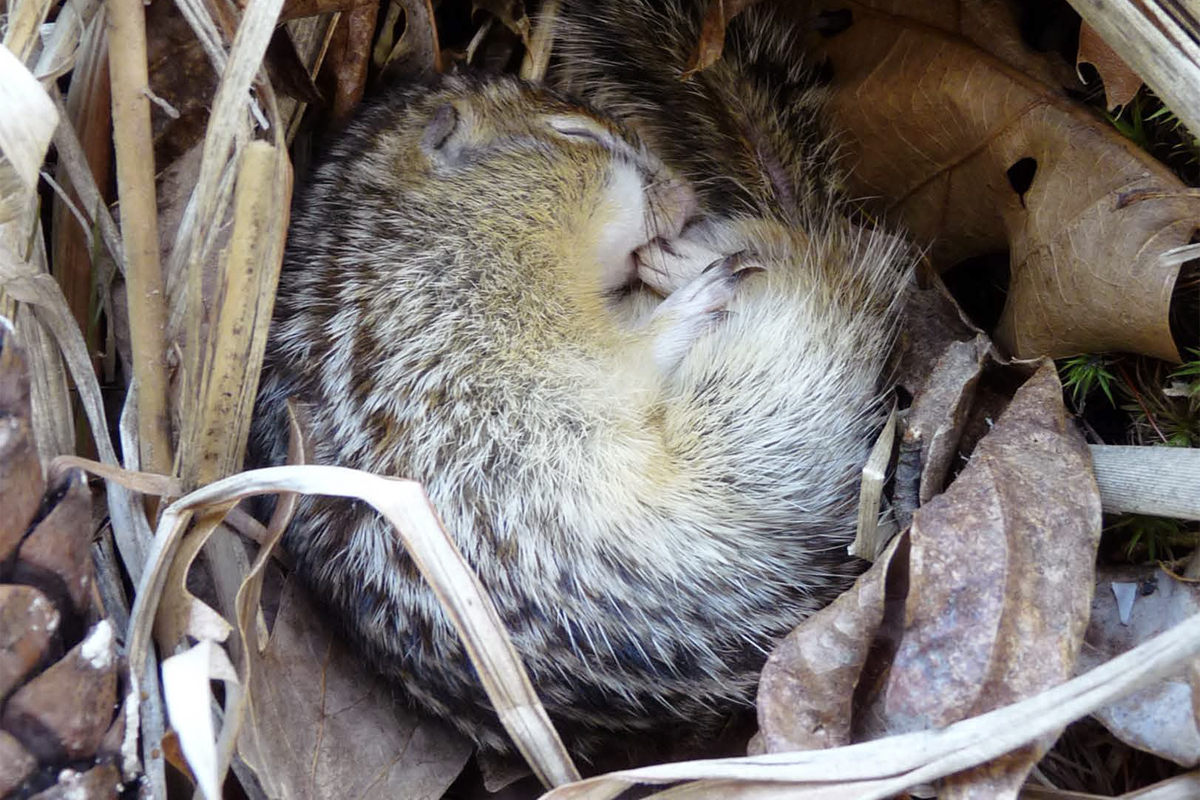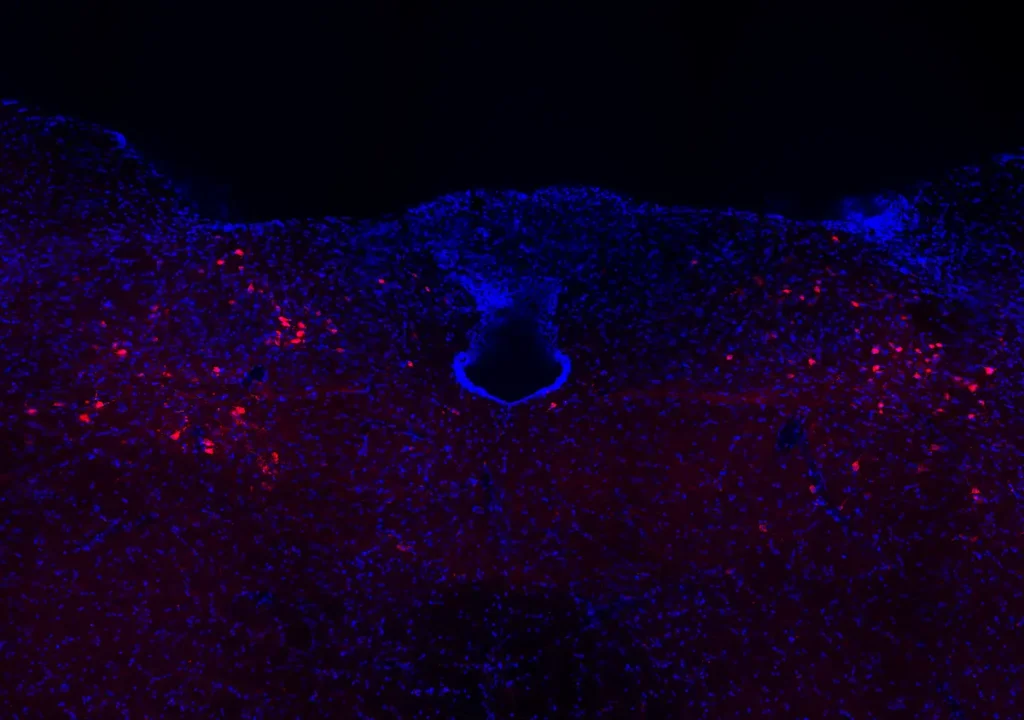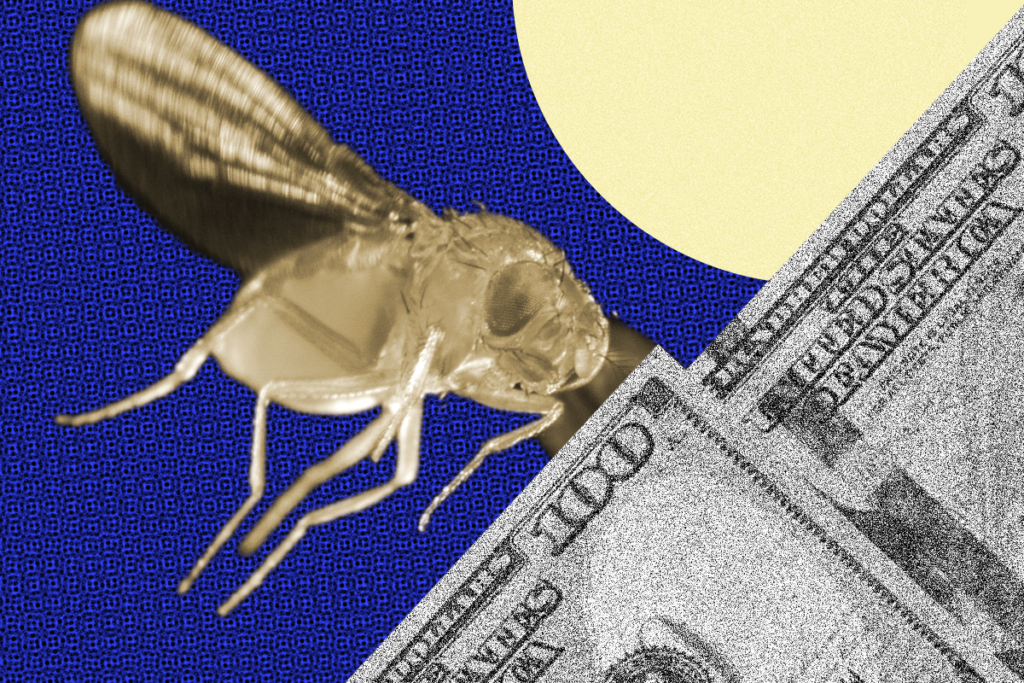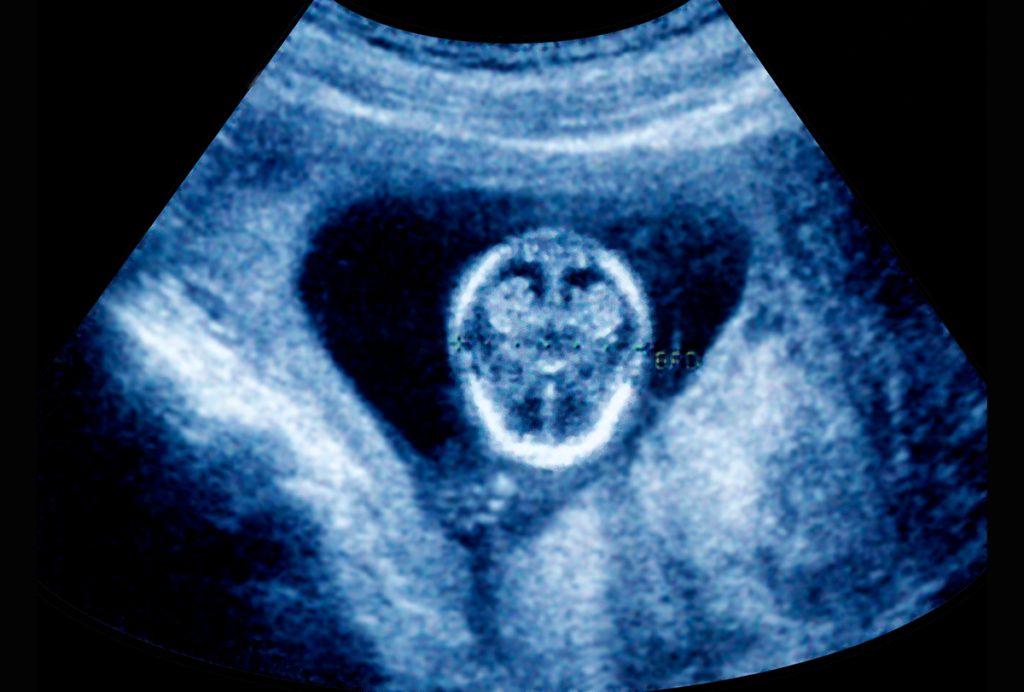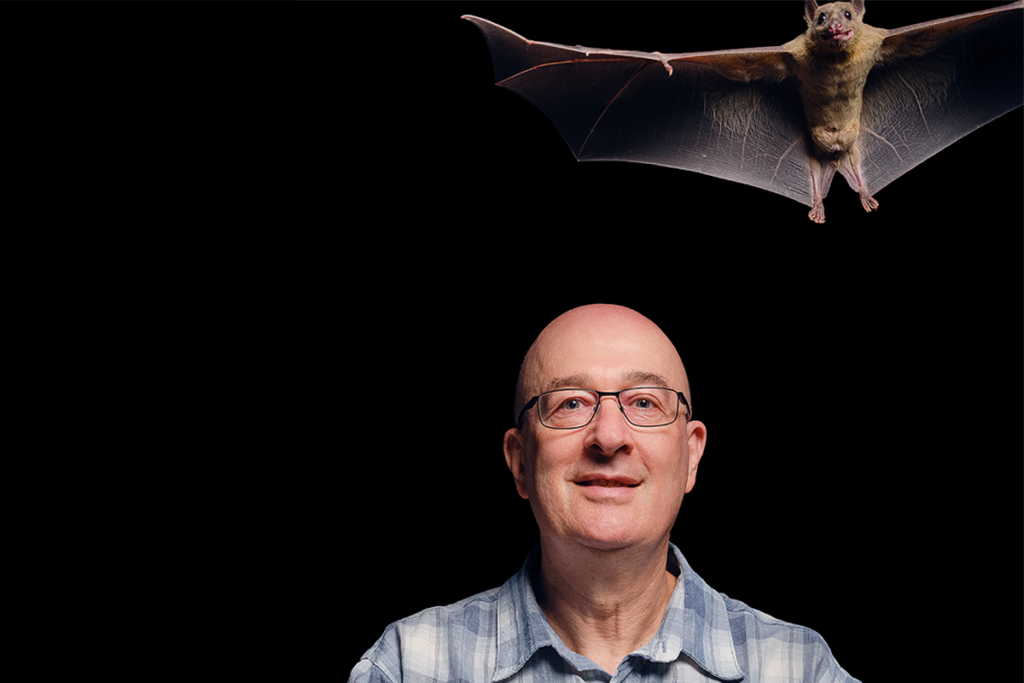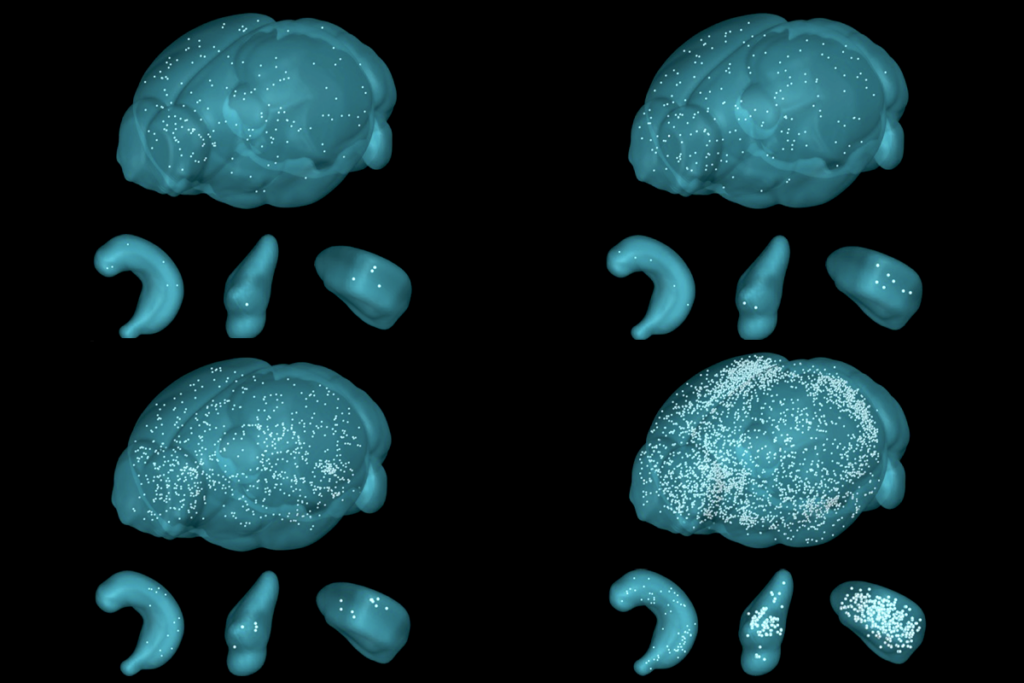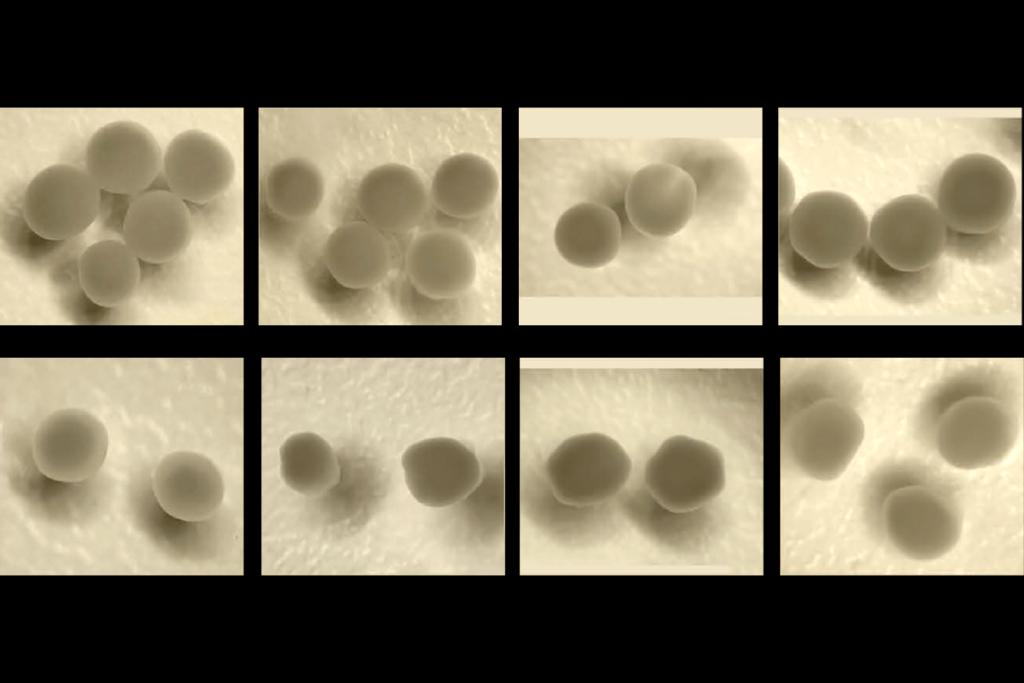In the Sterling Hall of Medicine at Yale University, a sign on a walk-in refrigerator door tells people to keep their voices down. Inside, about 250 ground squirrels are hibernating, each surrounded by shredded paper fluff and curled up in a clear plastic box. Shelves lined with these makeshift nests are bathed in red light that only the researchers can see, leaving the motionless animals in complete darkness.
From about September to April—roughly the hibernation season for these thirteen-lined ground squirrels, which have stripes reminiscent of a chipmunk—the temperature inside the homemade hibernaculum is set at 4 degrees Celsius. The tiny rodents’ body temperature is the same as the chilly air, and their breathing and heart rates slow to just a handful of breaths and beats per minute—an energy-conserving response known as torpor.
Scientists have studied this extreme physiological state for more than a century, says Elena Gracheva, whose bustling lab sits just outside the silent hibernaculum. But to date, they have focused mainly on physiological changes in individual peripheral organs that help an animal survive in cold temperatures. It is still unknown how the central nervous system regulates the process, she says. “We know a lot about physiology, but we don’t know the molecular basis.”
Gracheva, professor of physiology and neuroscience at Yale University, is part of a small cadre of scientists who have set their sights on revealing those neural hibernation controls, using advanced tools to explore how the brain and other organ systems work together to maintain homeostasis. Their efforts are opening a “new era” in hibernation research, says Shona Wood, associate professor of Arctic chronobiology and physiology at the Arctic University of Norway.
Understanding how the brain directs hibernation would not only help researchers learn how this state evolved in different animal models, Gracheva says, but it might also lead to findings that could help people better recover from brain injury by using cold temperatures and help manage food deprivation.
M
any mammals besides thirteen-lined ground squirrels hibernate, including Arctic ground squirrels, yellow-bellied marmots, bats, hedgehogs and a single species of lemur. Hibernation is also seen outside of mammals: At least one species of bird and even some cold-blooded amphibians display this physiological adaptation to save energy when temperatures drop and food becomes scarce.A few summers ago, under the light of the Arctic Circle’s midnight sun, Wood spent “quite a lot of nights sleeping on the sofa” in her office, waiting for her lab’s hibernating hamsters to warm up, one by one.
Hibernation is not a static process: Although the entire period can last for months, torpor periods are interrupted by idiosyncratic bouts of arousal. After Wood’s golden hamsters were inactive for a few days, their temperature, pulse and breathing would typically return to normal for about 12 hours, during which time they mostly stayed in their nest, ate and drank a little, and slept before re-entering torpor. She wanted to understand how the brain regulates these fluctuations from torpor to arousal and back again.
Neurons in the hypothalamus initiate torpor in mice and rats, according to a pair of studies published in Nature in 2020. But those rodents do not hibernate. And previous attempts to examine the torpor-arousal cycle were “based on waking the animal up on purpose,” which can cause them stress, Wood says.
To study the hamsters as they arouse naturally, she rigged an alarm to a sensor implanted in the hamsters’ brown fat, tissue that registers minute shifts in body temperature. And she set the alarm to wake her once the brown fat had warmed by half of a degree, a sign that they were arousing on their own.
Her sleepless nights paid off. As with the mice and rats, neurons in the hypothalamus were active while the hamsters entered torpor, according to the expression of the immediate early gene c-FOS, but not during spontaneous arousal. By contrast, three non-neuronal sites in the brain—specifically, the choroid plexus, pars tuberalis and third ventricle tanycytes—showed an uptick in cellular activity just as the hamsters came out of torpor. Wood and her colleagues published the findings in the Journal of Experimental Biology in May.
It is “very important” that Wood and her colleagues found “early modeling of specific cell types during hibernation, and this is related to also changes in seasons,” says Gracheva, who was not involved in the study. The work shows that these non-neuronal cell types outside the hypothalamus are “actually worth looking at,” Wood says.
C
ompared with the golden hamsters, thirteen-lined ground squirrels hibernate a bit differently: They typically do not eat or drink when they enter an arousal period. Because the squirrels can hibernate for up to seven months, that discrepancy raises questions about how these animals can survive, says Ni Feng, assistant professor of biology at Wesleyan University.It’s a mystery Feng pursued as a postdoctoral researcher in Gracheva’s lab, coming up with some intriguing answers. “We noticed that the osmolality of their blood was changing, depending on if they were active or in torpor or aroused,” Feng says.
Hibernating ground squirrels stay hydrated during torpor by temporarily decreasing the concentration of osmolytes such as sodium and potassium in their extracellular fluid, Feng reported in a 2019 study. The animals also show a drop in blood levels of vasopressin and oxytocin, antidiuretic hormones the pituitary gland releases to induce thirst and increase water retention.
By contrast, during arousals, the ground squirrels’ blood levels of electrolytes, metabolites and antidiuretic hormones returned to “awake” levels. But even though water was readily available in their enclosure during the experiment, some drank only a little, and others none at all, suggesting that their thirst is somehow still inhibited. The results could help explain why they typically do not leave their burrow in search of water until hibernation is over, Feng and her colleagues wrote in their paper.
Activity in the “osmosensory” part of the brain, the supraoptic nucleus neurons, controls this release of antidiuretic hormones, Feng discovered using in-vivo fiber photometry to monitor a fluorescent calcium sensor. She described the findings in a study earlier this year. Once the squirrels’ body temperature warms to about 10 degrees Celsius, these neurons ramp up their activity, which prompts the pituitary gland to release vasopressin and oxytocin. This activation comes at an extreme lower limit of this type of neural activity—“prohibitive for these processes in non-hibernators,” Feng and her colleagues wrote in their study.
To deliver the calcium sensor, Gracheva’s lab had to introduce an adeno-associated virus (AAV), which is exciting, says Kelly Drew, director of the Center for Transformative Research in Metabolism at the University of Alaska Fairbanks, who was not involved in the study. Gracheva has been “a pioneer there with the use of AAVs to introduce transgenes in the ground squirrels,” Drew says. “I really think we’re on the cusp of applying modern molecular tools to get at mechanistic understanding that has not been possible before.”
Another hormone adjustment keeps hibernating thirteen-lined ground squirrels from getting hungry during arousals, Gracheva’s team reported in a study published in July: a deficiency of the thyroid hormone T3 in the hypothalamus. Infusing T3 hormone into the hypothalamus reversed the anorexia the hibernating animals typically maintain, supporting the idea that the hunger suppression keeps them from leaving their burrows.
The results align with previous work that did not measure the actual amount of thyroid hormone in the brain but found “a slew of genes that seem to point towards less thyroid hormone in the brain during winter” in hamsters, says Sarah Mohr, a postdoctoral associate in Gracheva’s lab and an investigator on the new study.
G
racheva says her lab is busy applying modern neuroscience tools to other questions about hibernation, such as how the brain drives its seasonality and how animals can reach sexual maturity while they hibernate, deprived of food and water.She and others say they are also thinking about how they might one day translate their findings to people.
For instance, hibernation protects Arctic ground squirrels against brain injury, according to a study Drew led more than two decades ago. Normally, when you stick a probe in the brain, Drew says, you get “a big hole there,” but in the hibernating Arctic ground squirrel brain, “you had to use a microscope to find any evidence of where the probe was.”
Many animal studies suggest that cooling body temperature soon after a brain injury or stroke diminishes tissue injury. “It seems as [if] cold is the most neuroprotective aspect of hibernation,” Drew says, thanks to its ability to suppress free radical production and inflammation.
That protective cooling in the squirrels may result from rising levels of the neuromodulator adenosine, which accumulates in the brain throughout the day, helps control sleep and may also initiate hibernation, some studies suggest. In line with this idea, adenosine receptors in the animal’s brain show a seasonal shift in their ability to bind the neuromodulator, according to a 2023 study that Drew led. Drew says she is interested in developing a drug to alter the activity of adenosine receptors in the human brain to cool the body to take advantage of the neuroprotective effects after brain injury. But this is not a straightforward task, she adds, because “adenosine likely has peripheral effects as well.”
Gracheva—though focused on basic neurobiology—has established several collaborations with more clinical researchers also in hopes of translating her work down the road. Her lab has collaborated with researchers studying transplantation, for example, because squirrel organs, unlike human ones, can make it through periods of hypoxia and hypothermia. And studies of physiological anorexia could potentially turn up druggable targets too, she says.
“I think our line of research can help us to benefit society in the future.”
